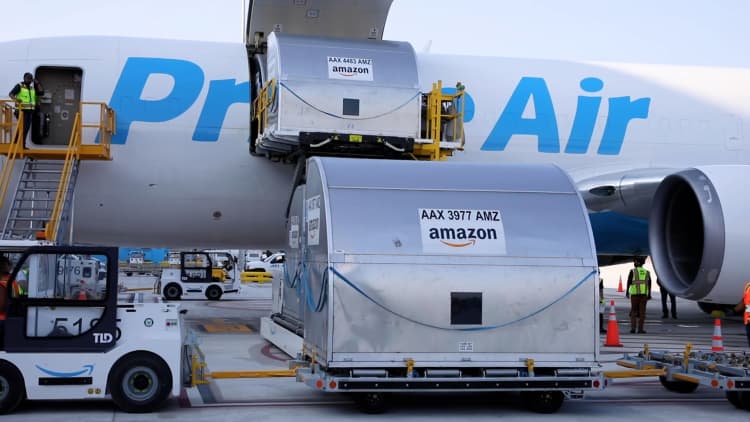
Inside the rapid growth of Amazon Logistics and how it's taking on third-party shipping
Amazon is now shipping packages for outside customers in its latest move to compete directly with FedEx and UPS. It's been on a spending spree to increase capacity of its in-house logistics network, which is up 50% from a year earlier. According to SJ Consulting Group, Amazon is now shipping 72% of its own packages, up from 46.6% in 2019.
Meanwhile, Amazon has learned a lot about how to keep costs down from the shippers who handle the remaining 28% of its deliveries. For example, Amazon still primarily outsources costly rural deliveries to the U.S, Postal Service, and outsources the expensive last-mile portion to delivery service partner contractors.
"What Amazon is able to do right now is sort of pick off probably the most attractive routes, the most attractive packages, and deliver to the most densely populated areas," said Dan Romanoff, who researches Amazon for Morningstar.
Some think there's a chance Amazon will try to buy other shippers outright.
"Down the road I think Amazon will be so big, so powerful, so wealthy, they will simply absorb UPS," said e-commerce consultant Chris McCabe, who was a seller performance investigator at Amazon from 2006 to 2012.
With seven years and 10 billion deliveries under its belt, Amazon Logistics, or AMZL, now has 400,000 drivers worldwide, 40,000 semi-trucks, 30,000 vans, and a fleet of more than 70 planes. Perhaps the biggest investment so far is the new $1.5 billion Amazon Air hub that opened in Kentucky in August.
For outside merchants, Amazon already offers a variety of shipping services. In the U.K., Amazon has a "logistics as a service" program, a business model that researchers from DePaul University predict Amazon will launch in the U.S. in the next 18 months, while Morgan Stanley predicted it could happen this year. According to one investigation, Amazon has already begun quietly transporting cargo on its planes for the postal service.
Amazon's algorithms also allow sellers to take advantage of LTL (less than load) truck space at discounted rates, while allowing Amazon to make money on otherwise wasted space. Amazon seller Keith Gregory just started using the program, called Amazon Freight. Gregory's vitamin and supplement company, Highland Laboratories, is based in a 3,500-person town in Oregon and does about $4 million of annual sales on Amazon. Gregory says Amazon charges up to $1,700 less than FedEx or UPS for some of his routes from Oregon to Southern California.
"For us being in a rural community, the fact that somebody is willing to cater to us, and they're willing to accommodate pick-up schedules and not just say, 'Okay, we'll be there every day at 3:30,' is also very attractive," Gregory said. "So not just not just the rate piece, but the fact that they're also willing to use their vast fleet of vehicles to help us with our logistics as well, which UPS and FedEx are not cooperative in that sense."
Amazon also offers its Fulfilled By Amazon, or FBA, services for orders not made on Amazon.com. That explains why some orders from eBay, Walmart and others arrive in Amazon packaging.
"There were points in time in our company's existence where really Amazon shipped 100% of our orders for all channels," said Amazon seller Bernie Thompson, who uses what Amazon calls multi-channel fulfillment for many of the consumer electronics sold by his company, Plugable Technologies.
"If you go today and buy a Plugable product on eBay, it's actually going to be coming from an Amazon warehouse and very often delivered by an Amazon delivery service," Thompson said.
Former Amazon product safety manager Rachel Greer says the current shipping expansion is reminiscent of other times Amazon has used immense resources and data to disrupt an industry, such as with Prime Video and Amazon Web Services.
"I was part of the process for making sure that FBA sellers were compliant more than a decade ago. And they were like, 'Well, we have excess capacity. Let's use it,'" Greer said. "And then when AWS started, we had excess capacity. Let's use it. So of course if Amazon develops a platform, it works well, and of course if it's going to have excess capacity, they're going to try to sell it to someone."
Jason Boyce, author of "The Amazon Jungle," said the big move is no surprise.
"If you look at all of the third-party services that they opened up to sellers over the years, including AWS, they had to become the best in the business to service their own," Boyce said. "And by bringing in additional revenue streams to help support scale, ultimately it brings down cost, creates more of a situation where they can gain more market share, more market power, and they are addicted to growth."
Watch the video to hear more from former Amazon executives and online sellers about how third-party shipping is the behemoth's next big venture.









